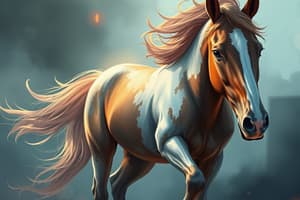Podcast
Questions and Answers
In the ruminant, the upper incisor teeth are replaced by a papilla.
In the ruminant, the upper incisor teeth are replaced by a papilla.
True (A)
The lingual frenulum is a thin band of tissue that connects the tongue to the roof of the mouth.
The lingual frenulum is a thin band of tissue that connects the tongue to the roof of the mouth.
False (B)
The papilla incisiva is a small median swelling on the lower incisor teeth.
The papilla incisiva is a small median swelling on the lower incisor teeth.
False (B)
The palatum durum is located ventrally in the mouth.
The palatum durum is located ventrally in the mouth.
The radix linguae is the apex of the tongue.
The radix linguae is the apex of the tongue.
The sulcus medianus is a groove on the ventral aspect of the canine tongue.
The sulcus medianus is a groove on the ventral aspect of the canine tongue.
The labium superius is divided by a median groove known as philtrum in the sheep and dog.
The labium superius is divided by a median groove known as philtrum in the sheep and dog.
The bucca is located dorsally in the mouth.
The bucca is located dorsally in the mouth.
The Canine tooth is only found in male horses.
The Canine tooth is only found in male horses.
The Carnassial teeth are found in the upper and lower first premolar teeth of carnivores.
The Carnassial teeth are found in the upper and lower first premolar teeth of carnivores.
The Wolf tooth is found in the lower first premolar tooth of a horse.
The Wolf tooth is found in the lower first premolar tooth of a horse.
Teeth can be divided into two types based on the distribution of enamel: Brachyodont and Hypsodont.
Teeth can be divided into two types based on the distribution of enamel: Brachyodont and Hypsodont.
The Enamelum is one of the three mineralised substances of the tooth.
The Enamelum is one of the three mineralised substances of the tooth.
The Radix dentis (Root) of the tooth is located at the gum line.
The Radix dentis (Root) of the tooth is located at the gum line.
The foliate papillae are located on the anterior part of the tongue.
The foliate papillae are located on the anterior part of the tongue.
Carnivores have a well-developed foliate papilla.
Carnivores have a well-developed foliate papilla.
Glandula labiale is a type of major salivary gland.
Glandula labiale is a type of major salivary gland.
The parotid duct in horses opens into the upper second cheek tooth.
The parotid duct in horses opens into the upper second cheek tooth.
The mandibular duct opens into the sublingual caruncle in all animals.
The mandibular duct opens into the sublingual caruncle in all animals.
Ruminants have a well-developed foliate papilla.
Ruminants have a well-developed foliate papilla.
The glandula zygomatica is present in ruminants.
The glandula zygomatica is present in ruminants.
The middle buccale gland is present in carnivores.
The middle buccale gland is present in carnivores.
Flashcards are hidden until you start studying
Study Notes
Teeth
- Types of teeth: Incisor, Canine, Premolar, Molar
- Wolf tooth: Upper first premolar tooth in horses
- Carnassial teeth: Sectorial teeth in carnivores, having three cusps
- Tooth structure:
- Enamel (Enamelum)
- Dentin (Dentinum)
- Cement (Cementum)
- Tooth parts:
- Corona dentis (Crown)
- Collum dentis (Neck)
- Radix dentis (Root)
- Tooth types:
- Brachyodont type: Short crowned, e.g., human, carnivores, pig, ruminant (lower incisor), equine (canine)
- Hypselodont type: Long crowned, e.g., equine, ruminant (cheek)
Digestive System
- Systema digestorium: Mouth, Pharynx, Alimentary canal, Associated organs
- Mouth parts:
- Labia oris (Rostrally): Upper lip (Labium superius) and lower lip (Labium inferius)
- Bucca (Laterally): Buccal glands
- Lingual frenulum: Connects tongue to the floor of the mouth
- Gums (Gingiva): Tissue surrounding teeth
- Palatum durum (Dorsally): Hard palate with raphe palati and palatum ridge (Rugae palatinae)
- Palatum molle (Dorsally): Soft palate
- Tongue (Ventrally)
- Teeth
- Salivary glands
Tongue
- Lingua (Tongue) parts:
- Radix linguae (Root)
- Corpus linguae (Body)
- Apex linguae (Apex)
- Frenulum linguae: Connects tongue to oral floor
- Sulcus median (Median groove) on dorsal aspect of canine tongue
- Features:
- Foliate papillae: Small vertical folds on tongue's posterolateral sides of base of tongue (present in horse and pig, rudimentary in ruminant, absent in carnivores)
Salivary Glands
- Function: Produce saliva for digestion, mouth moistening, and healthy teeth
- Types:
- Minor salivary glands:
- Glandula labiale: Microscopic glands in horse lips (absent in ruminant)
- Glandula buccales: Dorsal and ventral buccal glands
- Major salivary glands:
- Glandula parotis (Parotid gland): Location varies by species
- Glandula Mandibularis (Mandibular gland): Near jaw angle, covered by parotid gland
- Glandula sublinguales (Sublingual gland): Polystomatic and monostomatic types
- Minor salivary glands:
Studying That Suits You
Use AI to generate personalized quizzes and flashcards to suit your learning preferences.




